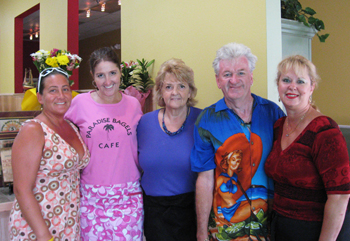Paradise Café moves and reopens the next day

SUN PHOTO/PAT COPELAND
From left, Amy Arnell, Cindy Thompson, Jackie Estes, and
Lyn and Sharon Clarke are waiting to serve you at the new
Paradise Café a few doors down from the old one.
HOLMES BEACH – Jackie Estes said the only times she has closed her restaurant, Paradise Café, in 15 years is when the Island evacuated for Hurricane Charley and last week when she moved to a new location.
“I had no choice,” she said, “but everybody’s really excited about the new place. In addition to what we had at the other place, it has a separate dining room.”
Estes was forced to move from her longtime location when Benderson Development Company agreed to relocate Walgreens from the north end of the Anna Maria Island Centre on East Bay Drive into the former Shell’s storefront at the south end of the center.
The plan includes an expansion into storefronts formerly occupied by Paradise Café and video and baby supply rental stores. Estes was given six weeks to construct a new restaurant and relocate the café.
“Cindy (co-owner Cindy Thompson) got all the permits and licenses,” Estes said. “I thought it would take a long time, but the city was so cooperative. Bob and Kurt (Building Inspector Bob Shaffer and Deputy Fire Marshal Kurt Lathrop) were wonderful.”
She also praised her building contractor, Fred Hayo, of Hayo Construction, her plumber Ron Davis and the members of her staff – Sharon and Lyn Clarke, Amy Arnell and Flo Bowen and sister JoJo Nickerson.
“We worked all day every day to get it done in the six weeks we had,” she said. “My choice was to close or start from scratch. My customers begged me to do it.”
Estes offers the same menu as the old location including customer favorites – plate-sized pancakes, jumbo muffins and bagels and lox platter, and she plans to add some salad selections and a Belgian waffle.
You can find Paradise Café a few doors down from the former location, where Estes will welcome you with her radiant smile and friendly greeting and make you instantly welcome.
Paradise Café
3220 East Bay Drive,
Holmes Beach
941-779-1212
Monday through Saturday
7 a.m. to 2 p.m.
Sunday
7:30 a.m. to 1 p.m.


